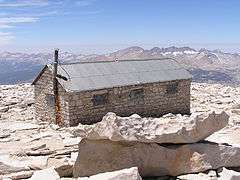Smithsonian Institution Shelter
|
Smithsonian Institution Shelter | |
|
The Smithsonian Institution Shelter, against the backdrop of the Sierra. | |
  | |
| Nearest city | Lone Pine, California |
|---|---|
| Coordinates | 36°34′43″N 118°17′32″W / 36.57861°N 118.29222°WCoordinates: 36°34′43″N 118°17′32″W / 36.57861°N 118.29222°W |
| Built | 1909 |
| Architect | Arch, Speiden & Speiden |
| Architectural style | Rustic architecture |
| NRHP Reference # | 77000119 |
| Added to NRHP | March 08, 1977[1] |
The Smithsonian Institution Shelter, also known as the Mount Whitney Summit Shelter, was built in 1909 on the summit plateau of Mount Whitney, in the Sierra Nevada within Sequoia National Park, in California.
History
The shelter at the summit was proposed after Byrd Surby, a U.S. Fisheries employee, was struck and killed by lightning on the summit in 1904. The shelter was built to house scientists who used the 14,505-foot summit to study high-altitude phenomena in the time before sustained high-altitude flight was possible.
In 1909 the site was used by Smithsonian Astrophysical Observatory director Charles Greeley Abbot to conduct spectroscopic observations of Mars to investigate the existence of water on the planet. Other studies included observations of cosmic rays and nocturnal radiation.[2][3]
Although the structure was built in part as a shelter from storms, hikers are now warned against seeking shelter there during lightning storms.
Landmark
Gustave F. Marsh, the builder of the summit trail, built the shelter with funding from the Smithsonian Institution, with assistance from the Lick Observatory. The mortared granite shelter comprises three rooms in a line with windows in each and doors in the north and south rooms. The roof is corrugated metal on a steel truss frame.[4] The shelter has a log book for all hikers to sign, that make it to the summit of Mt. Whitney. The site has been considered for National Historic Landmark status, but has not been recommended for submission yet.[5] However, in 1977 the Smithsonian Institution Shelter was placed on the National Register of Historic Places.
References
- ↑ National Park Service (2008-04-15). "National Register Information System". National Register of Historic Places. National Park Service.
- ↑ "SAO Mount Whitney Shelter Erected". Smithsonian Institution Research Information System. 2008-12-09.
- ↑ "Mt. Whitney's Early Days". Mount Whitney History. Lone Pine Chamber of Commerce. 2008-12-09.
- ↑ "Smithsonian Institution Shelter". List of Classified Structures. National Park Service. 2008-12-09.
- ↑ "National Register Sites considered but not recommended for designation as National Historic Landmarks". National Historic Landmarks: Astronomy and Astrophysics,Other Sites. National Park Service. 2008-12-09.

